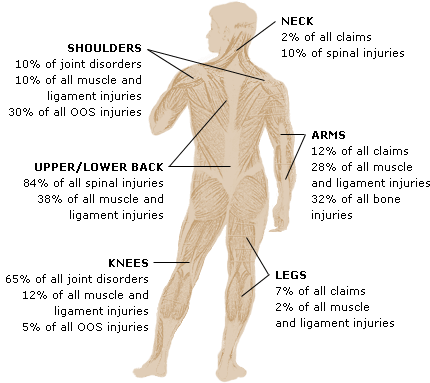Risks Of Exercise
|
As can be seen from the foregoing discussion, regular participation in an exercise program can provide several benefits. Yet exercise is similar to other medical or health interventions in that there are also potential costs associated with the activity. These costs range from minor inconveniences, such as time taken up by exercise, to more serious complications, including injury and even sudden death.
 It is clear that some people who participate in exercise training will develop injuries to their bones, muscles, and joints. Despite unfounded reports in the mass media of extremely high injury rates among adult exercisers, there have been few good studies of exercise injuries in populations. One of the difficulties in performing such studies has been the need to identify both the number of cases (individuals who become injured) and the number of persons at risk for injury (the total number of individuals exercising in the population). These two figures are necessary in order to calculate true injury rates. The best available studies on injury rates suggest that about 25 to 30 percent of adult runners will become injured over the course of a year, if injury is defined as an incident that causes an individual to stop exercising for at least one week. If only more serious injuries, such as those for which the individual seeks medical care, are considered, injury rates are much lower, perhaps in the range of 1 percent per year. Little is known about the causes of exercise injuries. One factor that has been linked to injury is the amount of exercise; for example, individuals who run more miles are likelier to be injured than those who run fewer miles. Factors such as age, sex, body type, and experience have not been shown to be associated with risk of injury. It seems logical that structural abnormalities, sudden increases in training intensity, and types of equipment used are likely to be related to injury risk; however, data to support these opinions are not available. In view of the limited scientific data on injury risk, the exerciser is advised to follow commonsense practices until such time as the causes of injury are better understood. Exercisers should start their program slowly and gradually progress to more intensive training levels. They should use good equipment and pay particular attention to proper footwear. Exercisers who have had previous injuries should recognize that they may be more susceptible to similar injuries in the future. All exercisers should use caution and should monitor their bodies for the early warning signs of injury. If a problem begins to develop, it is good advice to stop exercising or to reduce the intensity of training for a few days to see if the problem disappears. Exercisers should not be afraid to experiment on themselves to find out what training practices and techniques seem to be more comfortable and less likely to produce injury. Moderation is good advice: few injuries are reported in individuals who run 10 to 15 miles per week, and this level is adequate to provide many health benefits. Sudden deathObviously, the most serious complication from an exercise program is sudden death. This is, fortunately, a rare occurrence. As discussed earlier, several studies have shown that individuals who regularly participate in exercise have a lower risk of dying from a heart attack. There is, however, also evidence that suggests a higher risk of dying during exercise than during sedentary activities. When one considers the total risk of sudden death over a 24-hour period, regular exercisers are much less likely to experience this catastrophe. Virtually all individuals who drop dead suddenly have advanced coronary heart disease. It follows, therefore, that the best way to reduce the risk of sudden death during exercise is to avoid getting advanced coronary heart disease. This implies following good health practices in other aspects of life, such as not smoking, eating a prudent diet, and maintaining an ideal body weight. Individuals who are middle-aged or older can probably reduce their risk of sudden death by knowing about their coronary risk status and their general state of health before undertaking an exercise program. There are, of course, no guarantees, but if an individual has a thorough examination by a competent physician, including a maximal exercise test and other procedures that screen for coronary heart disease, that person can probably safely begin an exercise program.
|